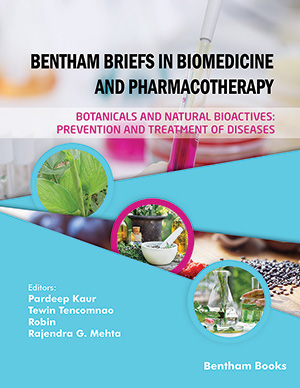摘要
背景:神经炎症在各种神经系统疾病的发生和发展中起着至关重要的作用。因此,各种研究集中于开发神经炎症抑制剂作为潜在的治疗工具。最近,自噬参与调节神经炎症引起了广泛的科学兴趣,越来越多的研究支持自噬受损在常见神经退行性疾病发病机理中的作用。 目的:本文的目的是回顾自噬在控制神经炎症中作用的最新研究。我们专注于利用哺乳动物细胞和动物模型评估不同自噬调节剂调节神经炎症的能力的研究。 方法:我们主要回顾了最近的研究,这些研究报告了自噬的抗神经炎特性。我们还简要讨论了一些研究,这些研究表明自噬调节剂在某些情况下会激活神经炎症。 结果:最近的研究报道了自噬调节剂的神经保护作用和抗神经炎症作用。我们讨论了这些药物可能的潜在作用机理及其作为针对神经系统疾病的治疗剂的潜在局限性。 结论:自噬激活剂是用于治疗涉及神经炎症的神经系统疾病的有前途的化合物。
关键词: 自噬,自噬调节剂,神经炎症,神经系统疾病,M2小胶质细胞,神经变性。
[http://dx.doi.org/10.1002/path.2697] [PMID: 20225336]
[http://dx.doi.org/10.15252/embj.201796697] [PMID: 28596378]
[http://dx.doi.org/10.1101/gad.1599207] [PMID: 18006683]
[http://dx.doi.org/10.1016/j.molcel.2010.09.023] [PMID: 20965422]
[http://dx.doi.org/10.1083/jcb.200809125] [PMID: 19029340]
[http://dx.doi.org/10.1038/emboj.2013.171] [PMID: 23921551]
[http://dx.doi.org/10.3390/ijms16022641] [PMID: 25625517]
[http://dx.doi.org/10.1016/j.ceb.2009.11.015] [PMID: 20022734]
[http://dx.doi.org/10.1126/science.1136880] [PMID: 17272685]
[http://dx.doi.org/10.1016/j.tibs.2010.07.007] [PMID: 20728362]
[http://dx.doi.org/10.1038/nn.2575] [PMID: 20581817]
[http://dx.doi.org/10.1038/nm.3232] [PMID: 23921753]
[http://dx.doi.org/10.1016/j.cell.2007.12.018] [PMID: 18191218]
[http://dx.doi.org/10.1016/j.neuroscience.2016.01.035] [PMID: 26827945]
[http://dx.doi.org/10.1016/j.expneurol.2007.07.004] [PMID: 17720159]
[http://dx.doi.org/10.1186/1750-1326-4-47] [PMID: 19917131]
[http://dx.doi.org/10.1016/S1474-4422(09)70062-6] [PMID: 19296921]
[http://dx.doi.org/10.1016/S1474-4422(11)70015-1] [PMID: 21349440]
[http://dx.doi.org/10.1016/j.bbi.2012.06.008] [PMID: 22728326]
[http://dx.doi.org/10.1016/S1474-4422(15)70016-5] [PMID: 25792098]
[http://dx.doi.org/10.1038/ncb0910-831] [PMID: 20811355]
[http://dx.doi.org/10.1016/j.cell.2010.01.028] [PMID: 20144757]
[http://dx.doi.org/10.1038/nature06639] [PMID: 18305538]
[http://dx.doi.org/10.1016/j.semcdb.2014.08.006] [PMID: 25158238]
[http://dx.doi.org/10.1016/j.ceb.2009.12.004] [PMID: 20056399]
[http://dx.doi.org/10.4161/auto.23323] [PMID: 23295650]
[http://dx.doi.org/10.1038/nrm4024] [PMID: 26177004]
[http://dx.doi.org/10.1074/jbc.M111889200] [PMID: 11897782]
[http://dx.doi.org/10.1002/path.2694] [PMID: 20225337]
[http://dx.doi.org/10.1091/mbc.e08-05-0544] [PMID: 18829864]
[http://dx.doi.org/10.1016/j.cell.2007.05.021] [PMID: 17632063]
[http://dx.doi.org/10.1242/jcs.01620] [PMID: 15615779]
[http://dx.doi.org/10.1101/cshperspect.a018358] [PMID: 24789822]
[http://dx.doi.org/10.1016/S0962-8924(03)00005-9] [PMID: 12628346]
[http://dx.doi.org/10.1242/jcs.01370] [PMID: 15340014]
[http://dx.doi.org/10.1091/mbc.12.11.3690] [PMID: 11694599]
[http://dx.doi.org/10.1074/jbc.M208191200] [PMID: 12364329]
[http://dx.doi.org/10.1038/ncb1740] [PMID: 18552835]
[http://dx.doi.org/10.4161/auto.1.1.1270] [PMID: 16874026]
[http://dx.doi.org/10.1091/mbc.e06-06-0479] [PMID: 17021250]
[http://dx.doi.org/10.1146/annurev-neuro-071013-014149] [PMID: 24821313]
[http://dx.doi.org/10.1002/dneu.22562] [PMID: 29197160]
[http://dx.doi.org/10.1083/jcb.201106120] [PMID: 22331844]
[http://dx.doi.org/10.1038/ng1591] [PMID: 15980862]
[http://dx.doi.org/10.1007/s00109-016-1461-9] [PMID: 27544281]
[http://dx.doi.org/10.1080/15548627.2017.1291114] [PMID: 28318364]
[http://dx.doi.org/10.1073/pnas.0903316106] [PMID: 19805182]
[http://dx.doi.org/10.1038/ncb2152] [PMID: 21258367]
[http://dx.doi.org/10.1038/nrm2245] [PMID: 17712358]
[http://dx.doi.org/10.1038/ncb2708] [PMID: 23524951]
[http://dx.doi.org/10.1016/j.molcel.2008.03.003] [PMID: 18439900]
[http://dx.doi.org/10.1038/nature07813] [PMID: 19262508]
[http://dx.doi.org/10.1073/pnas.0712145105] [PMID: 18296641]
[http://dx.doi.org/10.1042/BJ20150404] [PMID: 26348909]
[http://dx.doi.org/10.1038/onc.2014.390] [PMID: 25500539]
[http://dx.doi.org/10.1002/pros.23106] [PMID: 26440826]
[http://dx.doi.org/10.1126/science.1216990] [PMID: 22539722]
[http://dx.doi.org/10.4161/auto.27280] [PMID: 24429873]
[http://dx.doi.org/10.1073/pnas.0408345102] [PMID: 15596714]
[http://dx.doi.org/10.1042/BST20150020] [PMID: 26551712]
[http://dx.doi.org/10.1074/jbc.M110.118976] [PMID: 20452972]
[http://dx.doi.org/10.1083/jcb.200507002] [PMID: 16286508]
[http://dx.doi.org/10.1080/15548627.2015.1017224] [PMID: 25714272]
[http://dx.doi.org/10.1371/journal.pmed.1001755] [PMID: 25386878]
[http://dx.doi.org/10.1016/j.conb.2018.02.008] [PMID: 29529415]
[http://dx.doi.org/10.1186/s13041-017-0300-4] [PMID: 28610619]
[http://dx.doi.org/10.1523/JNEUROSCI.3049-12.2012] [PMID: 23223297]
[http://dx.doi.org/10.1016/j.celrep.2014.08.006] [PMID: 25199830]
[http://dx.doi.org/10.1371/journal.pgen.1006764] [PMID: 28557996]
[http://dx.doi.org/10.1016/j.cell.2010.10.007] [PMID: 21111239]
[http://dx.doi.org/10.1038/nature09782] [PMID: 21248839]
[http://dx.doi.org/10.1016/j.molcel.2014.03.030] [PMID: 24766892]
[http://dx.doi.org/10.1101/cshperspect.a006049] [PMID: 22296764]
[http://dx.doi.org/10.1056/NEJM199704103361506] [PMID: 9091804]
[http://dx.doi.org/10.1016/j.cell.2006.02.015] [PMID: 16497588]
[http://dx.doi.org/10.1038/ni.2237] [PMID: 22430786]
[http://dx.doi.org/10.1371/journal.ppat.1000661] [PMID: 20195505]
[http://dx.doi.org/10.1016/j.it.2011.01.003] [PMID: 21333600]
[http://dx.doi.org/10.1038/nature05911] [PMID: 17554300]
[http://dx.doi.org/10.1002/ibd.21486] [PMID: 21560199]
[http://dx.doi.org/10.1038/nature11582] [PMID: 23128233]
[http://dx.doi.org/10.1371/journal.pgen.1002406] [PMID: 22174698]
[http://dx.doi.org/10.1038/emboj.2011.398] [PMID: 22068051]
[http://dx.doi.org/10.1038/ni.1980] [PMID: 21151103]
[http://dx.doi.org/10.1038/nature09663] [PMID: 21124315]
[http://dx.doi.org/10.1038/ni.2215] [PMID: 22286270]
[http://dx.doi.org/10.1038/ni.2563] [PMID: 23525089]
[http://dx.doi.org/10.1371/journal.ppat.1002517] [PMID: 22319449]
[http://dx.doi.org/10.1016/j.immuni.2012.04.008] [PMID: 22658522]
[http://dx.doi.org/10.1038/ncomms2068] [PMID: 22990857]
[http://dx.doi.org/10.1016/j.chom.2012.01.019] [PMID: 22423967]
[http://dx.doi.org/10.1073/pnas.1210500109] [PMID: 23093667]
[http://dx.doi.org/10.1073/pnas.0704014104] [PMID: 17709747]
[http://dx.doi.org/10.1073/pnas.0911267106] [PMID: 19926846]
[http://dx.doi.org/10.1074/jbc.M110.202911] [PMID: 21228274]
[http://dx.doi.org/10.1042/EBC20170024] [PMID: 29233874]
[http://dx.doi.org/10.4161/auto.29647] [PMID: 25126727]
[http://dx.doi.org/10.1016/j.phrs.2014.02.008] [PMID: 24602800]
[http://dx.doi.org/10.1016/j.neuropharm.2014.05.032] [PMID: 24880087]
[http://dx.doi.org/10.1523/JNEUROSCI.0343-15.2015] [PMID: 26290229]
[http://dx.doi.org/10.1523/JNEUROSCI.3229-16.2017] [PMID: 28137967]
[http://dx.doi.org/10.1046/j.1471-4159.2000.0741017.x] [PMID: 10693932]
[http://dx.doi.org/10.1046/j.1471-4159.2001.t01-1-00240.x] [PMID: 11279286]
[http://dx.doi.org/10.3390/ijms18030598] [PMID: 28282924]
[http://dx.doi.org/10.1212/WNL.27.3.213] [PMID: 557755]
[http://dx.doi.org/10.1080/15548627.2017.1293766] [PMID: 28318352]
[http://dx.doi.org/10.1126/science.1099993] [PMID: 15528435]
[http://dx.doi.org/10.1096/fj.04-2751com] [PMID: 15791003]
[http://dx.doi.org/10.1074/jbc.M609532200] [PMID: 17182613]
[http://dx.doi.org/10.1038/cdd.2014.30] [PMID: 24632948]
[http://dx.doi.org/10.1016/j.celrep.2015.09.044] [PMID: 26489461]
[http://dx.doi.org/10.1038/srep19714] [PMID: 26792101]
[http://dx.doi.org/10.1007/s12035-016-9808-3] [PMID: 26957304]
[http://dx.doi.org/10.1016/j.expneurol.2017.08.007] [PMID: 28821398]
[http://dx.doi.org/10.1093/ijnp/pyw047] [PMID: 27207919]
[http://dx.doi.org/10.1016/j.neuro.2017.09.015] [PMID: 28986232]
[http://dx.doi.org/10.1007/s12035-017-0496-4] [PMID: 28357809]
[http://dx.doi.org/10.2174/187152710791292594] [PMID: 20406184]
[http://dx.doi.org/10.1111/j.1750-3639.2011.00546.x] [PMID: 22150926]
[http://dx.doi.org/10.1212/WNL.0b013e31826e25df] [PMID: 22972638]
[http://dx.doi.org/10.4161/auto.28784] [PMID: 24905722]
[http://dx.doi.org/10.1126/science.aaa3650] [PMID: 25700176]
[http://dx.doi.org/10.1038/nn.4000] [PMID: 25803835]
[http://dx.doi.org/10.1002/glia.22891] [PMID: 26200799]
[http://dx.doi.org/10.1126/science.aaf1064] [PMID: 26989253]
[http://dx.doi.org/10.1089/ars.2017.7271] [PMID: 28895473]
[http://dx.doi.org/10.1073/pnas.0708022105] [PMID: 18250315]
[http://dx.doi.org/10.1073/pnas.1206362109] [PMID: 22932872]
[http://dx.doi.org/10.4161/auto.25188] [PMID: 23851366]
[http://dx.doi.org/10.1038/nchembio.1563] [PMID: 24974230]
[http://dx.doi.org/10.3390/ijms18081666] [PMID: 28763002]
[http://dx.doi.org/10.1523/JNEUROSCI.2462-16.2016] [PMID: 28011744]
[http://dx.doi.org/10.1186/s12974-018-1101-0] [PMID: 29495962]
[http://dx.doi.org/10.1073/pnas.1002396107] [PMID: 20616033]
[http://dx.doi.org/10.3389/fncel.2017.00249] [PMID: 28871219]
[http://dx.doi.org/10.1038/nature08971] [PMID: 20428114]
[http://dx.doi.org/10.1016/j.yexcr.2014.01.020] [PMID: 24486447]
[http://dx.doi.org/10.1242/jcs.114926] [PMID: 23178947]
[http://dx.doi.org/10.1016/j.molmed.2016.04.006] [PMID: 27211305]
[http://dx.doi.org/10.1016/j.neuron.2017.11.032]
[http://dx.doi.org/10.1111/cns.12349] [PMID: 25417929]
[http://dx.doi.org/10.1016/j.bbrc.2011.06.117] [PMID: 21723251]
[http://dx.doi.org/10.1016/j.nbd.2015.10.001] [PMID: 26459113]
[http://dx.doi.org/10.1007/s12035-016-9824-3] [PMID: 26957299]
[http://dx.doi.org/10.1111/jpi.12337] [PMID: 27117839]
[http://dx.doi.org/10.1186/s12974-017-0959-6] [PMID: 28903766]
[http://dx.doi.org/10.1074/jbc.M109.033100] [PMID: 19535330]
[http://dx.doi.org/10.1016/j.intimp.2017.11.044] [PMID: 29197800]
[http://dx.doi.org/10.1016/j.mcn.2015.04.006] [PMID: 25936601]
[http://dx.doi.org/10.1016/j.neuint.2015.03.001] [PMID: 25770080]
[PMID: 28836399]
[http://dx.doi.org/10.18632/oncotarget.15774] [PMID: 28423639]
[http://dx.doi.org/10.1074/jbc.M110.100420] [PMID: 20178983]
[http://dx.doi.org/10.1523/JNEUROSCI.3944-09.2010] [PMID: 20089925]
[http://dx.doi.org/10.1038/ng1362] [PMID: 15146184]
[http://dx.doi.org/10.1074/jbc.M300227200] [PMID: 12719433]
[http://dx.doi.org/10.1016/0024-3205(95)02233-3] [PMID: 8594303]
[http://dx.doi.org/10.1016/j.neuroscience.2017.05.005] [PMID: 28504198]
[http://dx.doi.org/10.2165/00003088-200443020-00002] [PMID: 14748618]
[http://dx.doi.org/10.1096/fj.201600495R] [PMID: 27342766]
[http://dx.doi.org/10.1186/s12974-017-0797-6] [PMID: 28109197]
[http://dx.doi.org/10.1007/s12035-016-9827-0] [PMID: 26960330]
[http://dx.doi.org/10.1074/jbc.M109.060061] [PMID: 20080969]
[http://dx.doi.org/10.1016/j.bbi.2017.03.003] [PMID: 28268115]
[http://dx.doi.org/10.1097/WNR.0000000000000975] [PMID: 29360689]
[http://dx.doi.org/10.1002/mnfr.201600111] [PMID: 27296520]
[http://dx.doi.org/10.1111/acel.12446] [PMID: 26890602]
[http://dx.doi.org/10.1016/j.neuropharm.2016.04.041] [PMID: 27133377]
[http://dx.doi.org/10.1007/s11064-017-2322-9] [PMID: 28664399]
[http://dx.doi.org/10.1016/j.jep.2016.10.069] [PMID: 27793785]
[http://dx.doi.org/10.18632/oncotarget.21203] [PMID: 29228691]
[http://dx.doi.org/10.1016/j.ejphar.2014.01.061] [PMID: 24508518]
[http://dx.doi.org/10.1016/j.bbalip.2017.02.010] [PMID: 28254441]
[http://dx.doi.org/10.1038/nrd2681] [PMID: 18827828]
[PMID: 25576969]
[http://dx.doi.org/10.1371/journal.pone.0038113] [PMID: 22723850]
[http://dx.doi.org/10.1097/NEN.0b013e318283114a] [PMID: 23399896]
[http://dx.doi.org/10.1002/hipo.20883] [PMID: 21069780]
[http://dx.doi.org/10.1016/j.toxlet.2017.02.023] [PMID: 28245985]
[PMID: 24936215]
[http://dx.doi.org/10.1016/j.jneuroim.2005.02.022] [PMID: 15885809]
[http://dx.doi.org/10.1016/j.expneurol.2018.02.008] [PMID: 29453977]
[http://dx.doi.org/10.1111/jnc.14144] [PMID: 28796285]
[http://dx.doi.org/10.1016/j.freeradbiomed.2012.05.018] [PMID: 22634147]
[http://dx.doi.org/10.1016/j.oraloncology.2011.07.027] [PMID: 21856210]
[http://dx.doi.org/10.1016/j.neuropharm.2015.09.017] [PMID: 26384655]
[http://dx.doi.org/10.1111/cns.12683] [PMID: 28256059]
[http://dx.doi.org/10.1080/15548627.2017.1302045] [PMID: 28350199]
[http://dx.doi.org/10.7150/ijms.17514] [PMID: 28553165]
[http://dx.doi.org/10.1111/jnc.14051] [PMID: 28440874]
[http://dx.doi.org/10.2174/157015909787602788] [PMID: 19721818]
[http://dx.doi.org/10.1089/ars.2015.6549] [PMID: 27009601]
[http://dx.doi.org/10.1089/ars.2017.7003] [PMID: 28747068]
[http://dx.doi.org/10.1016/j.phrs.2017.04.028] [PMID: 28465217]
[http://dx.doi.org/10.1016/S1353-8020(11)70066-9] [PMID: 22166439]
[http://dx.doi.org/10.1002/glia.22610] [PMID: 24310907]
[http://dx.doi.org/10.1002/glia.22926] [PMID: 26446044]
[http://dx.doi.org/10.1152/jn.00425.2013] [PMID: 24598527]
[http://dx.doi.org/10.14348/molcells.2015.0131] [PMID: 26242194]
[http://dx.doi.org/10.1038/npp.2015.69] [PMID: 25759301]
[http://dx.doi.org/10.3233/JAD-151066] [PMID: 26890781]
[http://dx.doi.org/10.1038/cddis.2013.438] [PMID: 24201812]
[http://dx.doi.org/10.3892/ol.2017.6562] [PMID: 28928817]
[http://dx.doi.org/10.18632/oncotarget.9150] [PMID: 27153546]
[http://dx.doi.org/10.1371/journal.pone.0034776] [PMID: 22509356]
[http://dx.doi.org/10.1523/JNEUROSCI.1910-15.2015] [PMID: 26490872]
[http://dx.doi.org/10.1186/s12974-016-0658-8] [PMID: 27549088]
[http://dx.doi.org/10.1007/s12035-014-9019-8] [PMID: 25482048]
[http://dx.doi.org/10.1016/j.taap.2012.01.020] [PMID: 22310178]
[http://dx.doi.org/10.1186/1742-2094-9-49] [PMID: 22405189]
[http://dx.doi.org/10.2174/1871527314666150821102823] [PMID: 26295827]
[http://dx.doi.org/10.1089/neu.2014.3460] [PMID: 25046306]
[http://dx.doi.org/10.1007/s12035-015-9328-6] [PMID: 26143261]
[PMID: 25206601]
[http://dx.doi.org/10.1016/j.brainres.2013.11.030] [PMID: 24316245]
[http://dx.doi.org/10.1016/j.jsbmb.2015.01.002] [PMID: 25576906]
[http://dx.doi.org/10.1016/j.neuint.2011.11.015] [PMID: 22154800]
[http://dx.doi.org/10.1016/j.nbd.2013.07.011] [PMID: 23891729]
[http://dx.doi.org/10.1016/S0092-8674(01)00286-0] [PMID: 11290327]
[http://dx.doi.org/10.3389/fncel.2016.00273] [PMID: 27965540]
[http://dx.doi.org/10.1093/brain/aww042] [PMID: 27020329]
[http://dx.doi.org/10.1007/s11064-018-2494-y] [PMID: 29435803]
[http://dx.doi.org/10.1006/bbrc.1994.2428] [PMID: 7945395]
[http://dx.doi.org/10.1074/jbc.271.12.6839] [PMID: 8636108]
[http://dx.doi.org/10.1016/j.chembiol.2004.08.025] [PMID: 15556002]
[http://dx.doi.org/10.1177/0091270005282630] [PMID: 16291709]
[http://dx.doi.org/10.3892/ijo.2016.3748] [PMID: 27779641]
[http://dx.doi.org/10.18632/oncotarget.11385] [PMID: 27557491]
[http://dx.doi.org/10.1111/jphp.12567] [PMID: 27139338]
[http://dx.doi.org/10.1186/s12974-017-1013-4] [PMID: 29212498]
[http://dx.doi.org/10.1016/j.nbd.2010.05.014] [PMID: 20546895]
[http://dx.doi.org/10.1093/brain/aws143] [PMID: 22689910]
[http://dx.doi.org/10.2174/156720512800107573] [PMID: 22272607]
[http://dx.doi.org/10.1007/s12640-014-9487-7] [PMID: 25125332]
[http://dx.doi.org/10.1016/j.cell.2010.02.016] [PMID: 20303880]
[http://dx.doi.org/10.3389/fnagi.2017.00139] [PMID: 28555105]
[http://dx.doi.org/10.1038/nn.4338] [PMID: 27459405]
[http://dx.doi.org/10.1016/j.jns.2016.06.021] [PMID: 27423593]
[http://dx.doi.org/10.1016/j.bbi.2014.03.003] [PMID: 24632338]
[http://dx.doi.org/10.1007/s12035-014-9070-5] [PMID: 25598354]
[http://dx.doi.org/10.1016/j.bbadis.2009.10.010] [PMID: 19879944]
[http://dx.doi.org/10.1002/mds.26477] [PMID: 26813776]
[http://dx.doi.org/10.2174/0929867325666180226094351] [PMID: 29484979]
[http://dx.doi.org/10.1371/journal.pone.0188748] [PMID: 29186197]
[http://dx.doi.org/10.1007/s12031-017-1006-x] [PMID: 29243061]
[http://dx.doi.org/10.1155/2017/8385961] [PMID: 28127491]
[http://dx.doi.org/10.1038/nrneurol.2010.17] [PMID: 20234358]
[http://dx.doi.org/10.1016/j.semcdb.2015.03.005] [PMID: 25843774]
[http://dx.doi.org/10.4049/jimmunol.1303492] [PMID: 24829408]






























